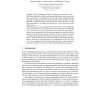Free Online Productivity Tools
i2Speak
i2Symbol
i2OCR
iTex2Img
iWeb2Print
iWeb2Shot
i2Type
iPdf2Split
iPdf2Merge
i2Bopomofo
i2Arabic
i2Style
i2Image
i2PDF
iLatex2Rtf
Sci2ools
EDBT
2006
ACM
2006
ACM
Multi-dimensional Aggregation for Temporal Data
Business Intelligence solutions, encompassing technologies such as multi-dimensional data modeling and aggregate query processing, are being applied increasingly to non-traditional data. This paper extends multi-dimensional aggregation to apply to data with associated interval values that capture when the data hold. In temporal databases, intervals typically capture the states of reality that the data apply to, or capture when the data are, or were, part of the current database state. This paper proposes a new aggregation operator that addresses several challenges posed by interval data. First, the intervals to be associated with the result tuples may not be known in advance, but depend on the actual data. Such unknown intervals are accommodated by allowing result groups that are specified only partially. Second, the operator contends with the case where an interval associated with data expresses that the data holds for each point in the interval, as well as the case where the data hol...
Associated Interval Values | Database | EDBT 2006 | Interval Data | Multi-dimensional Data Modeling |
| Added | 08 Dec 2009 |
| Updated | 08 Dec 2009 |
| Type | Conference |
| Year | 2006 |
| Where | EDBT |
| Authors | Christian S. Jensen, Johann Gamper, Michael H. Böhlen |
Comments (0)

